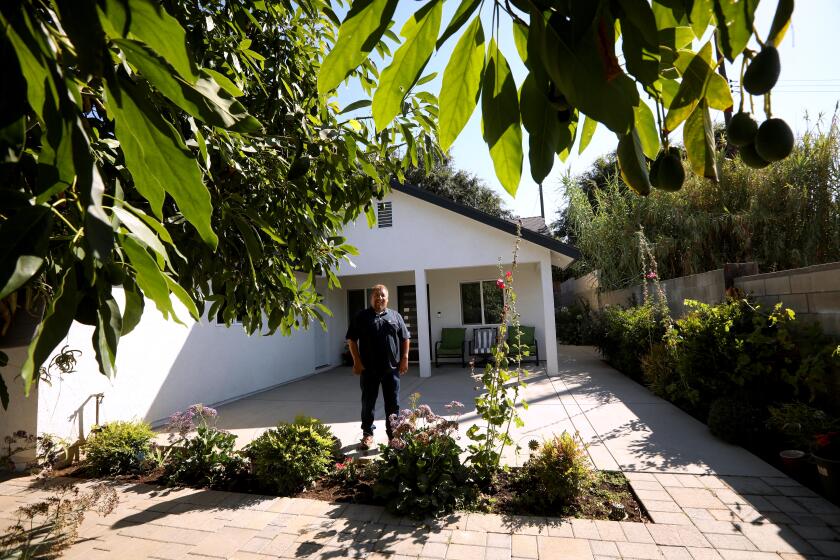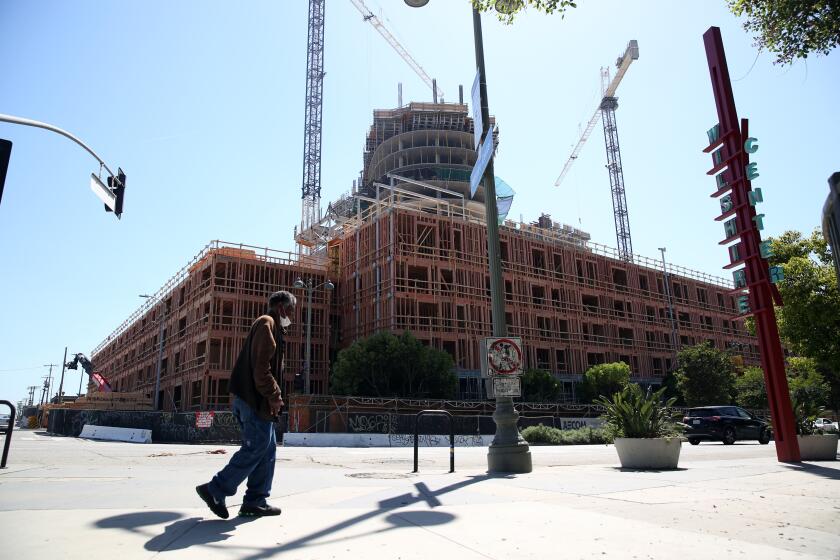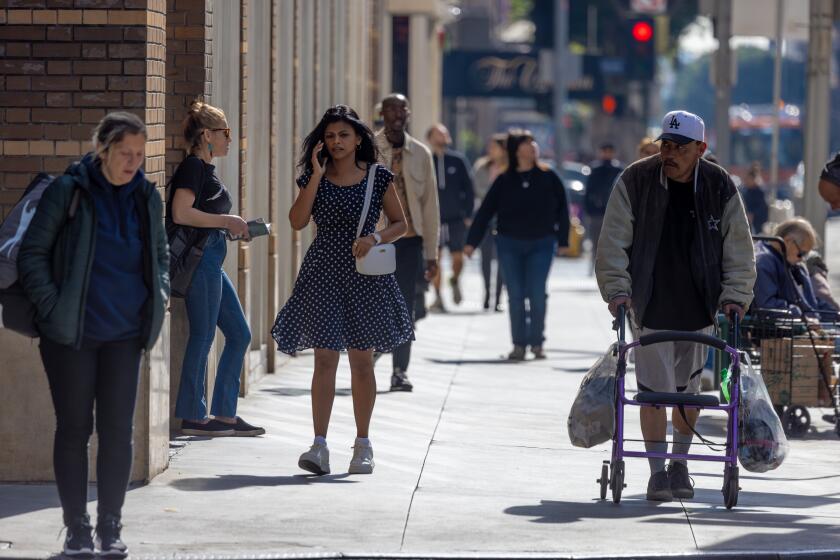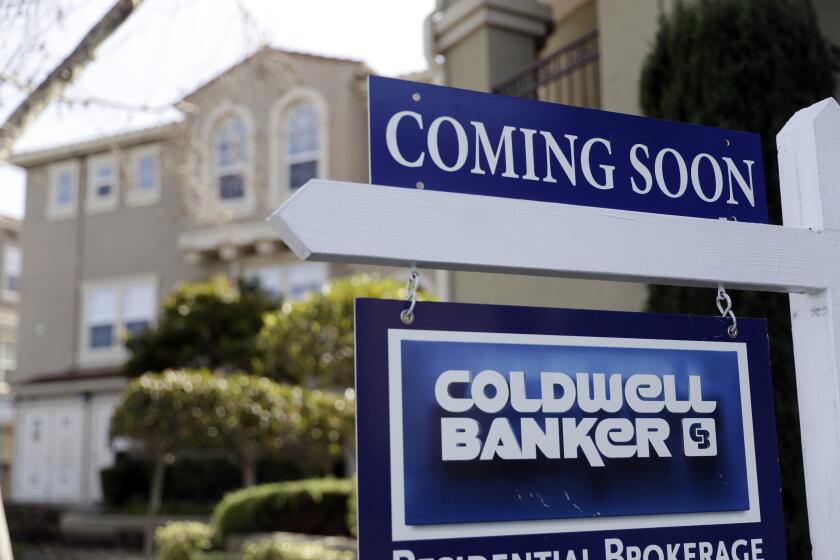Backyard ADUs booming in L.A. County. Why these surprising cities are building the most
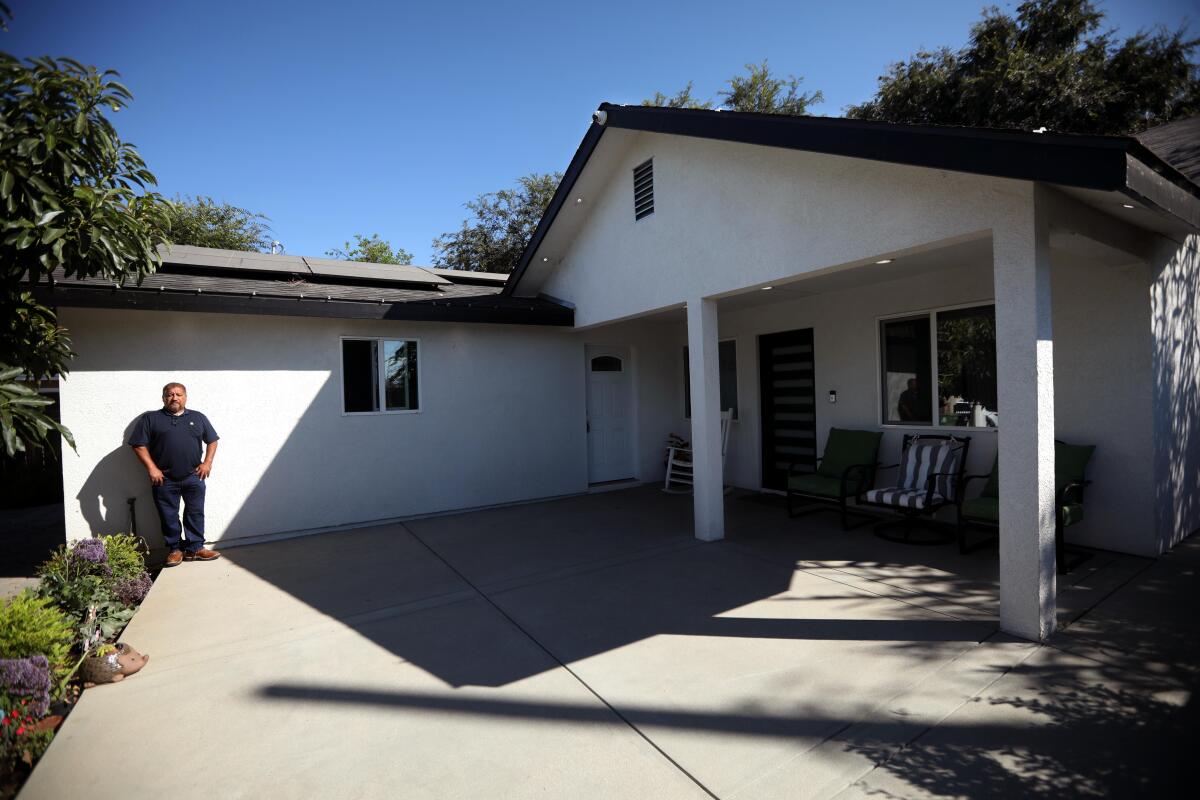
Los Angeles County has emerged as the capital of new backyard housing units, with a surprising array of communities leading the way, according to a Times data analysis.
L.A. has permitted more accessory dwelling units per capita than any other county in the state, with lower- and middle-income cities approving the most construction, the data show.
It’s too early to tell if the ADU boom has changed the region’s housing affordability crisis, which has pushed some to leave in search of homes more within their reach. But the data suggest that some cities that built the most ADUs saw smaller population losses than those that built the least.
Among the cities that permitted the most construction: San Fernando, Rosemead, Temple City, Sierra Madre and Hidden Hills.
The cities that built the fewest: Hawthorne, Commerce, Cudahy, Cerritos and Westlake Village.
The Times ranked every city in Los Angeles County by number of ADU permits per existing housing units. The top cities may surprise you.
It is not fully clear why some cities are building more. Experts say the speed and ease of the permitting process in each city is a likely reason some cities are at the top of the list, but other factors could include differing municipal regulations and varying single-family lot sizes that dictate whether there is enough room for extra backyard structures.
ADU builders say homeowners in low- and middle-income communities are more likely to rent out their new units for income — adding more units to the market — while ADUs in wealthier neighborhoods more often remain empty.
Hector Lopez, 55, has worked in construction in the San Fernando Valley since he was 16. He now runs a family contracting business, which allowed him to help build three ADUs in the city of San Fernando since 2021 for his children’s homes.
“It’s really hard nowadays for the new generation to buy a house,” he said, voicing a common complaint. So he built less-costly ADUs to generate the rental income that helps his children afford their mortgages.

At his daughter’s home, his company completed two ADUs: a 450-square-foot converted garage that rents for around $1,500 a month, and a 1,200-square-foot stand-alone unit that brings in $3,200.
At one son’s home, also in San Fernando, the family firm completed an 800-square-foot ADU six weeks ago. It is now listed for rent at $2,600. Lopez’s oldest son, who works for the construction firm, also bought a home in San Fernando and is in the process of obtaining permits for the family’s fourth ADU.
Lopez’s firm once specialized in building swimming pools, but since state regulations changed in 2016 to allow ADUs in an effort to relieve a statewide housing shortage, customers have flocked toward building rentable square footage. Pools are nice, he said, but with ADUs, customers “know they’re going to get something back from them.”
San Fernando is the capital of permitted ADUs in Los Angeles County, which is itself the epicenter of California’s housing shakeup. With nearly 70 ADUs permitted per 1,000 existing housing units in the last six years, the city boasts a permit rate that is more than three times as high as the county’s.
In turn, Los Angeles County has permitted by far the most ADUs of any county in the state: almost 22 per 1,000 existing structures between 2018 and 2023, per a Times analysis of California Department of Housing and Community Development data.
San Fernando’s boom is not solely about new structures, said Nick Kimball, the city manager. Many of the ADUs are “either converting existing structures like garages” or “putting an addition on a house,” he said.
His city’s housing stock consists mostly of older, relatively small single family lots, not the sprawling estates that would otherwise provide extra space for new housing units.
Developers built fewer homes in California in 2023, potentially leading to higher prices and rents as a supply shortage worsens.
In addition to new units, the state data capture “people legalizing what were formerly not conforming ADUs,” he said. “If there are people living there, we’d rather have it be safe and habitable.” Since state ADU regulations changed in 2016, researchers have found that Los Angeles and other parts of the county are home to a vast number of unpermitted ADUs.
In 2024, about two-thirds of permits issued for ADUs in San Fernando were conversions or add-ons, he said. The remaining one-third were new stand-alone structures.
When asked why his city has been so prolific, Kimball pointed to its sense of neighborly community and the power of word of mouth.
Additionally, “we’re a relatively easy city to work with,” he said, with a lack of bureaucracy that allows quicker processing times on ADU applications.
The other cities in L.A. County that have permitted the most ADUs share a culture of growth: faster permitting, fewer roadblocks and better interagency coordination, according to experts, developers and data analyzed by The Times.
After San Fernando, the next four cities in L.A. County that permitted the most ADUs were Rosemead, Temple City, Sierra Madre and Hidden Hills, each with 35 to 57 permits per 1,000 existing units.
Cities that permitted more ADUs saw other benefits, the analysis showed: The 20 cities that added the most ADUs saw their housing stocks increase by 1.8% on average from 2018 to 2023, while the bottom 20 cities added only 0.5% in the same span.
Amid the population loss during the California exodus, the top 20 cities with the most added ADUs recorded a population drop of 1.5% from 2018 to 2023, while the cities with the lowest numbers of added ADUs lost 2.6% of their populations.
It is unclear whether the ADUs are helping stave off population loss, but the data show that where more ADUs have been permitted, the problem is less severe.
The bottom five cities each saw fewer than four permits issued per 1,000 existing housing units.
More than half of California’s counties have populations lower than they were in 2019, according to data from the state Department of Finance. The state has yet to recover from the exodus.
Wealthier communities seemed to allow fewer ADUs than other cities in Los Angeles County, according to the analysis. The median household income of the 20 L.A. County cities that permitted the fewest ADUs was $110,000, more than 20% higher than the county’s median income level. The median household income of the 20 cities with the most permits was $91,000.
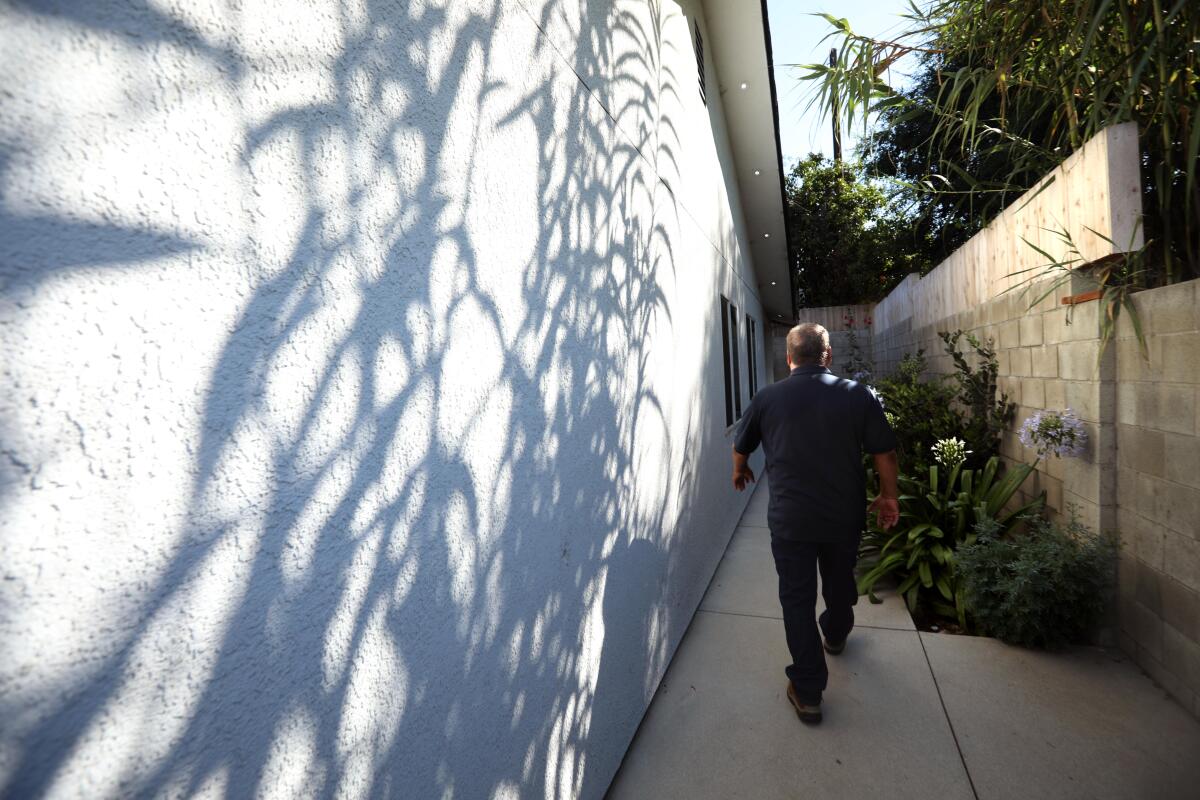
These findings mesh with conventional wisdom about how many cities operate, according to M. Nolan Gray, a city planner and the research director at California YIMBY, a pro-housing advocacy group.
Though state law dictates how quickly municipalities must process ADU and other housing applications, “in practice I think compliance with these laws is highly variable,” he said.
When a city is reluctant to add housing, “it’s not any policy on the books that can be identified, but [they’re] going to drag [their] feet,” he said. “If a jurisdiction really doesn’t want housing, they will impose some restriction to block it.”
Small-space living is a big trend in Southern California. Get inspired by these local ADUs and learn how to plan your own build.
Though state law protects people seeking to build, “the problem is the remediation options kind of suck,” he said. “You can initiate litigation,” but for small-scale projects it “basically never makes sense to do that.”
Gray argued that developers know where it’s easy and hard to build ADUs, a notion corroborated by builders like Charlie Melvin and Joseph Peretz, who were each able to rattle off lists of ADU-friendly and unfriendly cities from experience.
Additionally, they agreed that because a new ADU costs upward of $100,000, lower-income homeowners who build them are usually looking for rental income, while wealthier homeowners can afford to leave them empty or use them for family members.
Ultimately, Gray said he believes that even if some fraction of ADUs are built by wealthy people who never rent them out, the majority will become rentals, increasing the state’s housing stock at a time of dire need. “If you build them, people will live in them,” he said.
In wealthy Westlake Village, which reported a total of just four ADU permits issued in the five-year span, Planning Director Kirsten Asp said her city has complied with state regulations, but “it’s up to the individual property owner to decide whether they want an ADU.”
“We are pretty much a built-out city,” she said. “There is not vacant land that is available for new residential development,” so adopting denser zoning is the only way to increase the housing stock.
With the appropriate zoning in place, “it falls to the private sector and people who own those properties to either do something with that or not,” she said.
The median household income in Westlake Village is $189,000, nearly triple that of San Fernando, per census data.
San José became the first California city to let homeowners sell an ADU on their lot separately from their house. The goal is to boost homeownership.
Hector Lopez thinks his family’s fourth ADU will be its last before he retires after a 40-year career building homes. “I love what I do. It’s just nice to see something start to finish,” he said, “to build and see the end result.”
Lopez said his 77-year-old mother is also considering an ADU at her home to help pay her bills. By the time construction starts, he said, he hopes his son will take over the family business and help her build it.
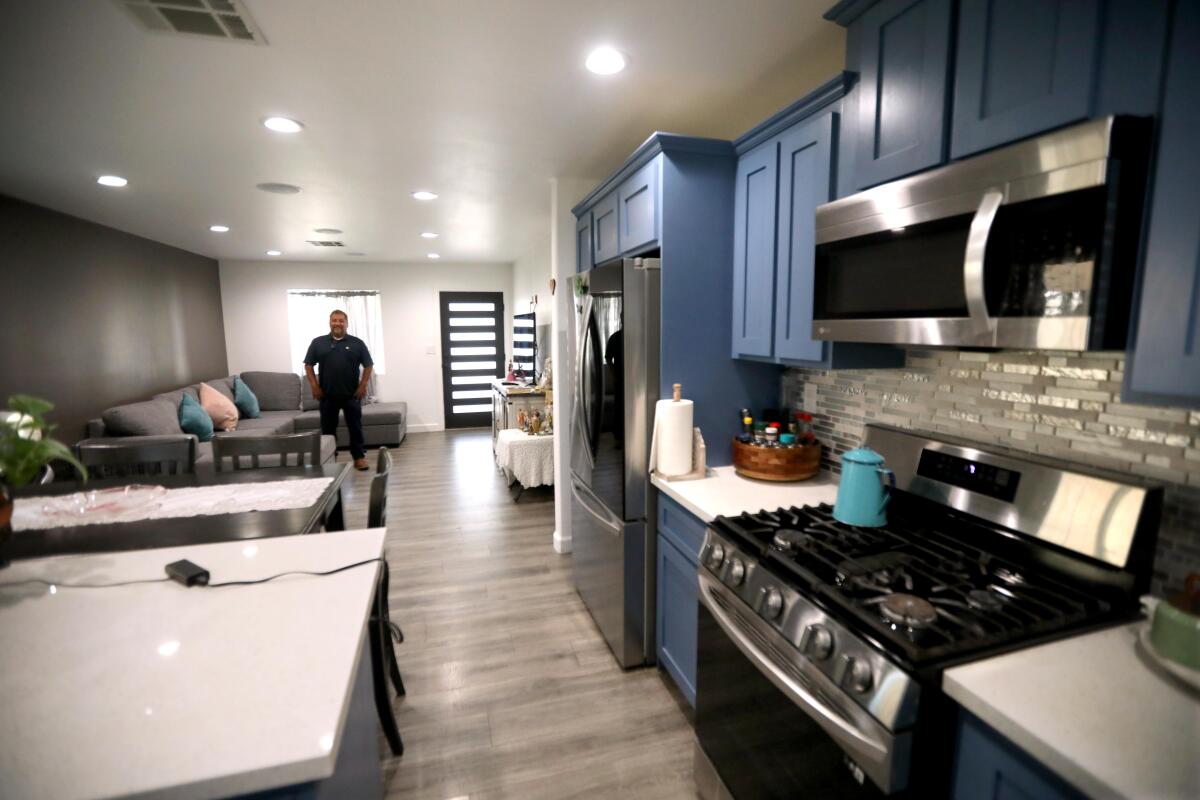
He saw and participated in an ADU craze that began in the San Fernando Valley but has now spread all over the county.
“I really believe ADUs are helping a lot,” he said. “There’s not enough housing and it’s just hard for the newer generation to accomplish the dream that they’re looking for.”
More Los Angeles ADUs
After 89-year-old mom pushed out of apartment, daughter adds accessible ADU
First, they built an ADU ideal for surfers. Now, they’re ready to travel like nomads
They spent $354,000 to build a modern ADU. Now they rent it out for $4,500 a month
How L.A. architects designed a 300-square-foot ADU that pulls in $1,750 a month
Three rentals and an ADU? A narrow two-story in Venice makes the case for building up
They turned their tiny L.A. garage into an ADU rental for steady income. Here’s how
Millennials and Gen Z can’t afford homes. Is this prefab ADU a solution?
How a Spanish bungalow in L.A. went from sad to sexy (Hint: There’s an ADU rental)
She wanted more than a guesthouse for her sister. This tiny ADU in L.A. delivers
This ADU rental with windows galore is a houseplant lover’s dream
How an aging Tudor’s ADU reunited a family and brought them closer together
More to Read
Subscriber Exclusive Alert
If you're an L.A. Times subscriber, you can sign up to get alerts about early or entirely exclusive content.
You may occasionally receive promotional content from the Los Angeles Times.

